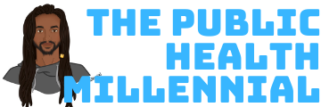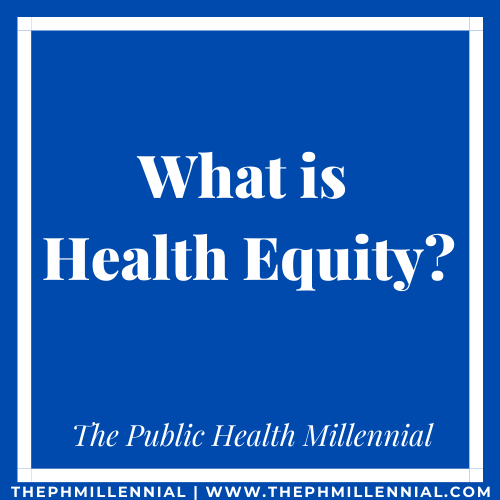In understanding public health you have to understand what is healthy equity.
Health equity plays a large role in the health that individuals experience throughout their lives. It’s crazy to think just because where you live or how you look can determine a myriad of the health outcomes.
Although health equities matter so much, they are still great needs to push for better understanding (from data and stories) and actions (strategies, advocacy, policies) to decrease these gaps.
Not only understanding what health equity is, but also how you can personally and systematically make forward movements to decrease health inequities. Let’s all work to better address health inequities around us.
Support The Public Health Millennial: https://www.buymeacoffee.com/thephmillennial
(Related: Overcoming Imposter Syndrome)
What Is Health Equity?
So what is health equity? Simply put it is the systematic differences in health and health outcomes between different populations because of social conditions like where people live, work, play, age and are born.
Health equity is defined by the APHA as, “By health equity, we mean everyone has the opportunity to attain their highest level of health.”
WHO defines health equity as, “‘Health equity or ‘equity in health’ implies that ideally everyone should have a fair opportunity to attain their full health potential and that no one should be disadvantaged from achieving this potential.”
And the Robert Wood Johnson Foundation defines it as, “Health equity means that everyone has a fair and just opportunity to be as healthy as possible. This requires removing obstacles to health such as poverty, discrimination, and their consequences, including powerlessness and lack of access to good jobs with fair pay, quality education and housing, safe environments, and health care.”
(Related: How To Search For Jobs During COVID-19)
How it arises?
Health equity arises from access to the social determinants of health.
The social determinants of health are the conditions in which people are born, grow, work, live, and age, and the wider set of forces and systems shaping the conditions of daily life. These forces and systems include economic policies and systems, development agendas, social norms, social policies and political systems.
The social determinants of health that are affected by health inequity include:
- Education and income;
- Unsafe or unhealthy housing;
- Stores and restaurants selling unhealthy food;
- Limited opportunities for residents to exercise, walk, or cycle;
- Proximity to highways, factories, or other sources of toxic agents;
- Limited access to primary care doctors and good hospitals;
- Unreliable or expensive public transit that isolates residents from good jobs, health and child care, and social services; and
- Residential segregation and features that isolate communities.
How to measure?
Clearly understanding what the true definition of health equity is essential. Since not accurately defining it will lead to poor methods to measure it, and ultimately the resources would not be distributed in the most equitable manner.
The WHO developed several measures for health equity, and can be obtained through various sources. These sources are:
- Population-based sources, such as household surveys, censuses and vital registration systems;
- Institutional sources, including resource records, service records and patient records;
- Trial or project reports; and
- Surveillance systems (which comprise both population-based data and institutional data).
It’s important to understand and measure the health equities throughout populations so that we are able to set up strategies to close these systematic inequities.
Additionally, complex frameworks have been developed to measure health equity as in this scientific journal article.

Health Equity vs Healthy Equality

Though health equity and health equality are similar terms. Heath equity should be the ideal that is strived for in our society and throughout our systems.
You probably have seen the image above showing the difference between equality and equity. The picture truly speaks volumes on the difference between healthy equity and health equality. It makes it easy to visualize why equity is more important to strive for than health equality.
If we strive for health equality, we will essentially leave communities in disadvantaged situations. Those that lack resources will not be given the resources, opportunities and supports they need to thrive.
Achieving health equity is essential to achieve the best quality of life and life expectancy for everyone.
| Example of Equity | Example of Equality |
|---|---|
| The city determines which times and how many hours communities actually need to use their community centers and reduces hours for centers that aren’t used as frequently | A city cuts the budget for 25 community centers reducing the operational hours for all centers by the same amount at the same time. |
| The community leader hire translators to attend the meeting or offer an additional meeting held in another language to ensure that community members are able to access information in English and Spanish, if needed. | A community meeting, where all members of the community are invited, about a local environmental health concern is held in English though English is not the primary language of 25% of the residents. |
It’s clear that when equal treatment is given to communities the most vulnerable populations still end up with the short end of the stick. This is why it is important to distinguish the difference between health equity and health equality. Because focusing on equality and not equity does not do as much perceived good.
Example of Health Equity
Picture health equity in this sense (this was taken from Boston Public Health Commission), “imagine that you’re standing amongst a group of 30 people. Everyone in the group is given a size 9 pair of sneakers. While it’s exciting to have been given free sneakers, there are only four people in group who are a size 9, therefore the majority of people won’t be able to wear the sneakers. While the size 9 sneakers were equally distributed to everyone in the group, it wasn’t equitable because not everyone wears that size.”
As you can see in this example, giving people resources that does not fit their needs is not going to help everyone. There needs to be an intentional approach to get the right and adequate amounts of resources to specific communities.
Importance of Health Equity
Factors like our race, ethnicity and socioeconomic status should not play a role in quality of life and life expectancy. Unfortunately, this is not the case. How healthy someone is and how long they live is intrinsically linked to their social conditions which are usually outside of the individuals complete control.
As I showed earlier, understanding inequities more-so than inequalities can have big impacts on the health outcomes of a population. Equality may help some vulnerable populations get the resources they need. But equality will still leave the most vulnerable populations without the adequate resources and supports they need.
Health equity is important because “pursuing health equity means striving for the highest possible standard of health for all people and giving special attention to the needs of those at greatest risk of poor health, based on social conditions.”
In order to affect positive health change to communities, demographic and other health equity related measures need to be taken to help start conversations about health inequities.
How can we better anything if we aren’t correctly measuring it?
This has been the case with COVID-19 as some states are collecting racial data which shows just how affected some communities of color are compared to whites.
(Related: 6 Months At My Public Health Fellowship|5 Lessons)
Health Equity and COVID-19
Interestingly, COVID-19 has begun to shine a light on health inequities especially among persons of color. This has begun to show up not only in because of social issues but also economical ones.
Truths of Health Inequities
Red lining & Wealth Gap – You probably have heard the phrase zip code determines life expectancy. There is a lot of truth in this, check out this interactive map from the CDC. This stems primarily from legally discriminatory policies where maps were literally red lined to deny financial services for black communities. This occurred for mortgage loans, insurance, and other banking services essentially creating underinvestment and a lack economic stability to grow in black communities.
In 2016, white families ($171,000) had nearly ten times a greater net worth than black families ($17,150). Blacks make up 13% of the US population, but only account for 3% of the countries wealth. Black communities have also suffered poor quality education, bias in the workplace, and lack of opportunities.
Health & Access – Not only is there a lack of access to health care for black communities, there is also lack of access to grocery stores. Blacks are 2X (Hispanics are 3X) as likely to be uninsured compared to whites. Blacks are more likely to report not being able to see a doctor because of cost than other races. Black communities tend to have greater barriers to access to transportation or public transportation to get to grocery stores or healthy food locations.
This along with other factors leads to communities that suffer disproportionally from chronic conditions. Blacks have higher rates for Obesity as well as chronic conditions (across all age groups) for:
- Astma
- High Blood Pressure
- Diabetes
- Stroke
Which leads them to being in higher risk groups to be fatally impacted by COVID-19.
Employment – Blacks for some of the reasons stated above are more likely to work low paying wage jobs. These jobs usually are paid minimum wage with no benefits or paid sick leave. Since they are low payed workers they don’t have the financial resources to be able to stay home in the midst of a pandemic. This leads many lower income people (lots of black people) to continue to go to work even when it might not be safe.
COVID-19 Stats
Now to look at the stats from COVID-19. The CDC stated that there is an overrepresentation of black among hospitalized patients.
In New York City, the death rate among blacks was 92.3 per 100,000 population, 74.3 for hispanics and 45.2 for whites and 34.5 for Asians.
The table below shows the percent distribution of deaths involving COVID-19 in the United States. It also includes the weighted distribution of the US population.
Although it shows relatively similar statics by race, when you dig into certain communities you will see just how disparaged some black communities are. Also the larger proportion of whites in the US plays into the overall distribution of COVID-19 deaths.
If you want a state to state look at COVID related deaths click here.
| Indicator | Non-Hispanic White | Non-Hispanic Black or African American | Non-Hispanic American Indian or Alaska Native | Non-Hispanic Asian | Hispanic or Latino | Other |
|---|---|---|---|---|---|---|
| Distribution of COVID-19 deaths (%) | 52.1 | 21.2 | 0.3 | 6.1 | 16.5 | 3.8 |
| Weighted distribution of population (%) | 40.4 | 18.4 | 0.2 | 12.1 | 26.9 | 1.9 |
(Related: How To Write A Cover Letter | 2020)
What You Can Do To Improve Health Equity
The sad thing about health equities is that they stems from centuries of discrimination and systematic oppression. Only when we are able to change the systems and the policies that govern life will we be able to truly decrease health inequities.
The RWJ Foundation has a ‘Culture of Health Action Framework’ to improve health equity:
- Making health a shared value
- Fostering cross-sector collaboration to improve well-being
- Creating healthier, more equitable communities
- Strengthening integration of health services and systems
With the outcome of the ‘Culture of Health Action Framework’ being: improved population health, well-being and equity.
RWJ Foundation also set aside 4 steps to advance health equity:
- Identify important health disparities that are of concern to key stakeholders, especially those affected. Identify social inequities in access to the resources and opportunities needed to be healthy that are likely to contribute to the health disparities.
- Change policies, laws, systems, environments and practices to eliminate inequities in the opportunities and resources needed to be healthy.
- Evaluate and monitor efforts using short-term and long-term measures.
- Reassess strategies to plan next steps.
As an Individual
Firstly, if you can improve a factor from social determinants of health in communities, it can have great benefit. The CDC has produced a guide on Promoting Health Equity: a resource to help communities address social determinants of health. Read this resource and decided which part of the larger system you would like to play a part in improving.
Nothing will change unless the policies are changed. Therefore you must go out an advocate for issues that matter to you and your communities health. Advocate for other disenfranchised communities and show support. Absolutely go out and vote – show representation. Speak up and lead social change initiatives.
We need to get the voices at the table that have not historically been heard from. This underrepresented groups know what’s better for them than any politician or researcher. A great way to facilitate this would be using community based participatory research methods when working with underserved communities. Allow and nurture emerging leaders from within these underserved communities. Let’s ensure we have a diversity of voices on issues that affect diverse communities.
There have been some pushes forward in improving tax code to get investment into ‘opportunity zones.’ It accomplishes this by trying to send private capital into neighborhoods that have been historically disparaged. But community stakeholders need to be a part of this conversation to impact robust change.

Summary
Health equity plays an important role in how we all live and the health we have.
Health equity can be defined as: the systematic difference in health and health outcomes between different populations because of social conditions like where people live, work, play, age and are born. It arises from the social determinants of health which are the social conditions mentioned above.
The need to decrease health equities is crucial in order for everyone to achieve the best quality of life and longer life expectancies.
COVID-19 has disproportionately affected some communities of color. Especially as many of the chronic conditions from these population place them in higher risk groups for COVID-19 deaths.
Although health equities matter so much, they are still great needs to push for better understanding (from data) and actions (strategies, advocacy, policies) to improve these gaps.
Let’s all work to better address health inequities around us.
Why do you think health equity is important?




Pingback: Reflection: 11 Months At My Public Health Fellowship - The Public Health Millennial
Pingback: The Dilemma of Contact Tracer Jobs For Public Health Professionals - The Public Health Millennial